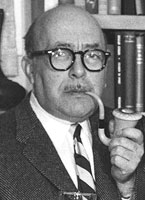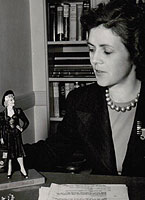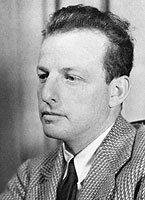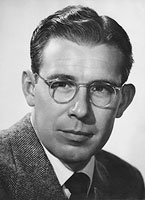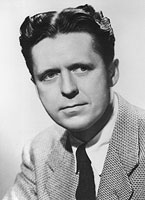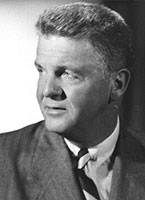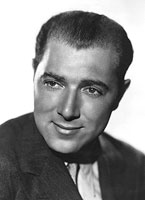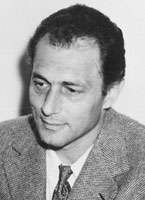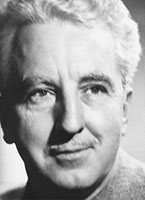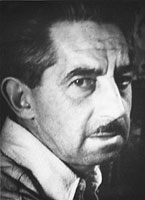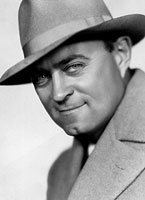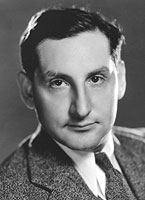Screen Writers Guild
Presidents
F. Hugh Herbert
1953-1954Frederick Hugh Herbert wrote for the theater, film, television, and radio from the 1920s until 1958. His more than 80 screenwriting credits include a collaboration with another WGAw president and fellow writer... FULL BIO
Richard L. Breen
1952-1953Writer and first WGAw president Richard Breen’s films include A Foreign Affair (1948), Miss Tatlock’s Millions (1948), Niagara (1953), Seven Cities of Gold (1955), Pete Kelley’s Blues (1955), State Fair (1962), and Captain Newman, M.D. (1963)... FULL BIO
Mary C. McCall Jr.
1951-1952First woman president of the Screen Writers Guild, Mary Caldwell McCall Jr. wrote or co-wrote the screenplays for A Midsummer Night’s Dream (1935), Craig’s Wife (1936), The Sullivans (1944), Mr. Belvedere Goes to College (1949)... FULL BIO
Karl Tunberg
1950-1951Karl Tunberg wrote or co-wrote Rebecca of Sunnybrook Farm (1938), Down Argentine Way (1940), the Oscar-nominated Tall, Dark and Handsome (1941), Orchestra Wives (1942), the WGA- and Oscar-nominated Ben-Hur (1959), and episodes of the television series Bonanza, Mannix... FULL BIO
Valentine Davies
1949-1950Valentine Davies is best known for writing the Academy Award-winning story for Miracle on 34th Street (1947) in collaboration with writer-director-producer George Seaton... FULL BIO
George Seaton
1948-1949George Seaton won two best screenplay Academy Awards for Miracle on 34th Street (1947) and The Country Girl (1954), and earned nominations for The Song of Bernadette (1943) and Airport (1970)... FULL BIO
Sheridan Gibney
1947-1948Sheridan Gibney shared Academy Awards with co-writer Pierre Collings for original story and screenplay for The Story of Louis Pasteur (1936). He co-wrote I Am a Fugitive from a Chain Gang (1932) with Howard J. Green and Brown Holmes... FULL BIO
Emmet Lavery
1945-1947Emmet Lavery and co-writer Milton Sperling earned an Academy Award nomination for their screenplay The Court Martial of Billy Mitchell (1955). Lavery’s television movie Magnificent Yankee (1950) won five Emmys. One of his earliest plays... FULL BIO
Lester Cole
1944-1945A Screen Writers Guild founder, Lester Cole wrote more than 40 films, including The Invisible Man Returns (1940), The House of Seven Gables (1940), Objective Burma (1945), The Romance of Rosy Ridge (1947), High Wall (1947)... FULL BIO
Mary C. McCall Jr.
1942-1944First woman president of the Screen Writers Guild, Mary Caldwell McCall Jr. wrote or co-wrote the screenplays for A Midsummer Night’s Dream (1935), Craig’s Wife (1936), The Sullivans (1944), Mr. Belvedere Goes to College (1949)... FULL BIO
Sidney Buchman
1941-1942Sidney Buchman’s screenwriting career began with The Sign of the Cross (1932) for Cecil B. DeMille, and really took off with his first hit, Theodora Goes Wild (1936). His credits include Mr. Smith Goes to Washington (1939)... FULL BIO
Sheridan Gibney
1939-1941Sheridan Gibney shared Academy Awards with co-writer Pierre Collings for original story and screenplay for The Story of Louis Pasteur (1936). He co-wrote I Am a Fugitive from a Chain Gang (1932) with Howard J. Green and Brown Holmes... FULL BIO
Charles Brackett
1938-1939Charles Brackett was an attorney, critic, novelist, writer, and producer with more than 40 film credits. His collaboration with screenwriter-director Billy Wilder resulted in such memorable films as Ninotchka (1939), A Foreign Affair (1948), and they received best screenplay Oscars for The Lost Weekend (1945)... FULL BIO
Dudley Nichols
1937-1938Writer, director, and producer Dudley Nichols’ writing and co-writing credits include Men Without Women (1930), the Academy Award-winning The Informer (1935), Bringing Up Baby (1938)... FULL BIO
Ernest Pascal
1935-1937Novelist, playwright, and screenwriter Ernest Pascal was active from the silent era through the 1950s. His screen credits include Chastity (1923), The Savage (1926), Wedding Rings (1930), Lloyds of London (1936)... FULL BIO
Ralph Block
1934-1935A founding member of the Screen Writers Guild and its first treasurer, Ralph Block was active from the 1920s to 1950, writing westerns, dramas, and musicals such as The Arizona Kid (1930), The Right to Live (1935), In Caliente (1935)... FULL BIO
John Howard Lawson
1933-1934First president and co-founder of the Screen Writers Guild, John Howard Lawson was one of the first screenwriters to write for talkies. He was active from 1928 until 1947, when he became one of the blacklisted “Hollywood Ten,”... FULL BIO

